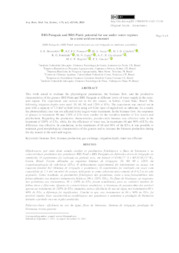BRS Paiaguás and BRS Piatã: potential for use under water regimes in a semi-arid environment.
BRS Paiaguás and BRS Piatã: potential for use under water regimes in a semi-arid environment.
Author(s): MARANHÃO, S. R.; POMPEU, R. C. F. F.; SOUZA, H. A. de; CÂNDIDO, M. J. D.; FONTINELE, R. G.; LOPES, M. N.; CAVALCANTE, A. C. R.; ROGERIO, M. C. P.; GUEDES, F. L.
Summary: Abstract: This work aimed to evaluate the physiological parameters, the biomass flow, and the productive characteristics of the grasses BRS Piatã and BRS Paiaguás at different levels of water supply in the semiarid region. The experiment was carried out in the dry season, in Sobral, Ceará State, Brazil. The following irrigation depths were used: 30, 60, 90, and 120% of ETo. The experiment was carried out in pots with a capacity of 7.5 dm³ at field level, using a 0-0.2m layer of argisol soil as substrate. As a result, the photosynthetic rate was not affected in the largest water treatments. In the biomass flow, the responses of grasses to treatments 90 and 120% of ETo were similar for the variables number of live leaves and phyllochron. Regarding the productive characteristics, pseudo-culm biomass was effective only in the treatment of 120% of ETo, while, for the efficiency of water use, in treatments 60 and 90% of ETo, the difference was effective. In conclusion, in the treatments of 60 and 90% of the ETo, it was possible to maintain good morphological characteristics of the grasses and to increase the biomass production during the dry season in the semi-arid region. Resumo: Objetivou-se, por meio deste estudo, avaliar os parâmetros fisiológicos, o fluxo de biomassa e as características produtivas das gramíneas BRS Piatã e BRS Paiaguás em diferentes níveis de irrigação no semiárido. O experimento foi realizado no período seco, em Sobral (3°45'00,77'' S e 40°20?38,55?? W), Ceará, Brasil. Foram utilizadas as seguintes lâminas de irrigação: 30; 60; 90 e 120% da evapotranspiração de referência (ETo). O delineamento experimental foi inteiramente ao acaso, em esquema fatorial 4x2 (lâminas de irrigação x gramíneas). O experimento foi realizado em vasos com capacidade de 7,5 dm3 em nível de campo, utilizando-se como substrato uma camada de 0-0,2 m de solo argissolo. Como resultado, os parâmetros fisiológicos das gramíneas, como a taxa fotossintética, não foram afetados nos maiores tratamentos hídricos (90 e 120% ETo). No fluxo de biomassa, as respostas das gramíneas aos tratamentos, 90 e 120% da ETo, foram semelhantes para as variáveis número de folhas vivas e filocrono. Quanto às características produtivas, a biomassa de pseudocolmo foi sensível apenas no tratamento de 120% de ETo, enquanto, para a eficiência do uso da água, nos tratamentos 60 e 90% de ETo, a diferença foi significativa. Conclui-se que, nos tratamentos de 60 e 90% da ETo, foi possível manter boas características morfológicas das gramíneas e aumentar a produção de biomassa durante o período seco na região semiárida.
Publication year: 2024
Types of publication: Journal article
Unit: Embrapa Goats & Sheep
Keywords: Biomass flow, Biomass production, Brasil, Brazil, Capim Urochloa, Dry season, Eficiência no uso da água, Fluxo de biomassa, Forage grasses, Forage production, Gas exchange, Gramínea Forrageira, Irrigation depth, Lâminas de irrigação, Parâmetros fisiológicos, Photosynthesis, Physiological functions, Physiological parameters, Produção de biomassa, Semiarid zones, Semiárido, Taxa fotossintética, Trocas gasosas, Urochloa brizantha, Water use efficient
Observation
Some of Embrapa's publications are published as ePub files. To read them, use or download one of the following free software options to your computer or mobile device. Android: Google Play Books; IOS: iBooks; Windows and Linux: Calibre.
Access other publications
Access the Agricultural Research Database (BDPA) to consult Embrapa's full library collection and records.
Visit Embrapa Bookstore to purchase books and other publications sold by Embrapa.

